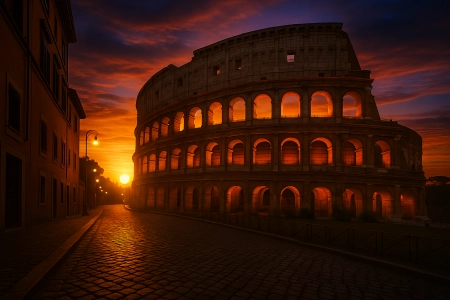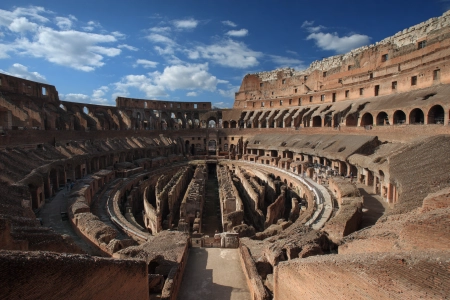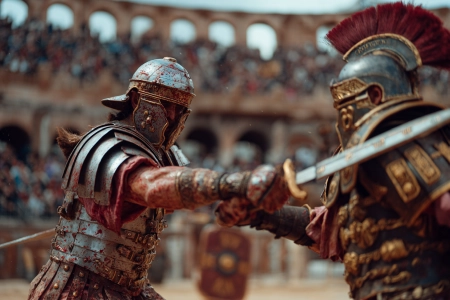The Roman Colosseum: Arena of Blood, Glory and Empire
Where Rome staged power as entertainment—the Roman Colosseum turned blood, skill, and spectacle into the language of empire.
Reading time: ~9-10 min
Introduction
Few monuments capture the drama of ancient Rome like the Roman Colosseum (the Flavian Amphitheatre). Completed in the late 1st century CE, the stone ellipse embodied imperial ambition: a people's arena where emperors staged gladiator games, animal hunts, executions, and pageantry to demonstrate the wealth, order, and power of the Roman state. At its peak, crowds in the tens of thousands surged through its arches to watch the rituals of blood and glory unfold on the arena floor.

Today, the Colosseum stands not just as a ruin of spectacle, but as a masterclass in Roman architecture and engineering, an index of social hierarchy, and a study in how empires use entertainment as propaganda—bread, circuses, and control.
Construction & Purpose: Vespasian, Titus, Funding, Propaganda
From a Private Lake to a Public Arena
The Colosseum rose where Nero had built his private pleasure grounds—the Domus Aurea—with an artificial lake. After Nero's fall, Vespasian (r. 69-79 CE) of the Flavian dynasty reclaimed the site for the people. By converting a symbol of imperial excess into a public amphitheatre, he sent a clear political message: the Flavians would restore Rome and reward its citizens.
- Start of construction: c. 70-72 CE
- Inauguration: 80 CE under Titus (r. 79-81 CE)
- Further works: Domitian (r. 81-96 CE) completes subterranean systems and seating
Who Paid for It?
Spoils and tribute from the Jewish War (66-73 CE) likely contributed to financing and labor. Building a grand, free-to-enter arena turned plunder into popularity: lavish shows (ludi and munera) knitted emperor and populace together.
Why Was It Built?
- To provide mass public entertainment—gladiatorial contests, wild-beast hunts, staged executions
- To reassert civic order after civil war and Nero's excesses
- To display imperial generosity and technical prowess—propaganda in stone and travertine
Key idea: In the Colosseum, politics and entertainment were inseparable. Spectacle cemented loyalty.
Design & Engineering: Roman Concrete, Velarium, Hypogeum Mechanics
Size and Plan
The Colosseum's elliptical plan optimized sightlines and circulation.
- Outer dimensions: about 189 m x 156 m
- Height: c. 48-50 m at the outer façade
- Arena: c. 87 m x 55 m
- Capacity: commonly estimated 50,000-65,000

Materials and Structure
The building combined travertine blocks (clamped with iron), tufa, brick, and Roman concrete to create a resilient skeleton of barrel vaults and annular corridors. Its tiered arches—Tuscan, Ionic, Corinthian—were both decorative and structural, distributing loads around the ellipse.
The Velarium
A vast velarium—a canvas awning—was rigged to shade spectators. Sailors from Rome's fleet likely managed the ropes, masts, and pulleys. While not covering the entire seating bowl, it reduced heat and glare, another example of Roman logistical planning.
The Hypogeum: Tunnels, Lifts, and Stagecraft
Under Domitian, the Colosseum gained the hypogeum, a two-level honeycomb of corridors, cells, and machinery beneath the arena floor.
- Animal cages and holding pens for venationes
- Capstans, winches, and elevators hoisting scenery, cages, and combatants through trapdoors
- Stage effects engineered surprise entrances—from predators to mythic tableaux
Spectacle & Society: Gladiator Types, Munera, Damnatio ad Bestias
Program of a Day
- Morning: venationes (animal hunts) featuring exotic beasts
- Midday: executions (including damnatio ad bestias)
- Afternoon: gladiator games (munera)—the headline acts
Gladiators: Training and Types
Gladiators were trained professionals, often enslaved, condemned, or volunteers seeking fame or prize money. They practiced at nearby schools, notably the Ludus Magnus, connected to the arena by a subterranean corridor.
- Murmillo: large shield, gladius, crested helmet
- Retiarius: net, trident, dagger; minimal armor; mobility-focused
- Thraex & Hoplomachus: smaller shields, curved or thrusting blades, varied helmets
How Did Gladiator Fights End?
Contrary to Hollywood, bouts often ended when one fighter was wounded or exhausted, signaling missio (reprieve) or defeat. A referee enforced rules. Death occurred, but constant fatalities would have been economically irrational; elite fighters represented significant investment.
Seating Hierarchy: Society in Stone
The Colosseum encoded Roman social order with strict seating:
- Podium: senators and elite
- Next rings: equestrians
- Middle tiers: citizens
- Uppermost galleries: women and the lowest status groups (with exceptions)
- Special boxes for the emperor and Vestal Virgins
How Many Died in the Colosseum?
Ancient figures are inflated and modern estimates vary widely. Over centuries, thousands likely died—gladiators, prisoners, and animals—but any precise number is speculative. The key is the civic function of public violence: instruction, catharsis, and imperial messaging.

Pull quote: “The Colosseum was not merely a theatre of violence; it was a classroom of empire.”
Myths vs Reality: Christian Martyrdom and Flooded Naval Battles
Were Christians Martyred in the Colosseum?
Roman persecution of Christians occurred, but the Colosseum itself is not securely documented as a primary site of systematic martyrdom. Later tradition sacralized the arena; evidence is mixed and debated.
Did the Arena Flood for Naval Battles (Naumachiae)?
Rome staged naumachiae elsewhere. Early, limited water displays inside the Colosseum may have been attempted, but after the hypogeum was built, large-scale flooding became impractical.
Roman Colosseum Architecture Explained (At a Glance)
- Form: elliptical amphitheatre, concentric rings of vaulted corridors
- Structure: travertine façade on concrete/tufa core; radial & annular vaults
- Circulation: ~80 entrances; efficient vomitoria
- Comfort/Control: velarium, fountains, latrines, seating rules
- Stagecraft: hypogeum (tunnels, lifts, trapdoors)
- Style: superimposed orders (Tuscan/Ionic/Corinthian)
Decline & Afterlife: Earthquakes, Quarrying, Restorations, UNESCO Legacy
Late Antiquity to the Middle Ages
As the western empire contracted (4th-6th centuries CE), expensive games dwindled. The Colosseum saw sporadic use, damage from earthquakes (notably in 847 and 1349 CE), and repurposing as housing, workshops, and a fortress. For centuries, it served as a quarry for travertine and iron clamps.
Early Modern to Modern Conservation
By the 18th-19th centuries, papal initiatives and antiquarians began to protect the ruins. Archaeology exposed the hypogeum and stabilized arches. Twentieth- and twenty-first-century campaigns continue restoration and visitor management. Today, the Colosseum forms part of UNESCO's World Heritage listing for the Historic Centre of Rome.
Timeline: Flavian Amphitheatre History
- 64-68 CE: Nero's Domus Aurea and artificial lake occupy the site
- c. 70-72 CE: Vespasian begins amphitheatre construction
- 80 CE: Titus inaugurates with games and festivals
- 81-96 CE: Domitian completes the hypogeum and seating refinements
- 4th-6th Century CE: Games decline; arena repurposed
- 847 & 1349 CE: Major earthquakes inflict heavy damage
- 18th-19th Century CE: Antiquarian interest; papal protections; early conservation
- 20th-21st Century CE: Excavation, restoration, and UNESCO-era stewardship
Frequently Asked Questions
Why was the Roman Colosseum built?
To provide free public entertainment and project Flavian power. Transforming Nero's private lake into a public amphitheatre signaled imperial generosity, order, and engineering prowess.
What happened in the Colosseum?
Gladiator games (munera), animal hunts (venationes), and public executions (including damnatio ad bestias) filled full-day programs from morning to late afternoon.
How big is the Colosseum?
About 189 m x 156 m, roughly 48-50 m high, with an arena around 87 m x 55 m. Seating capacity is commonly estimated at 50,000-65,000.
How did gladiator fights end?
Usually when one fighter was wounded or overmatched. Officials could grant missio (reprieve) or declare defeat. Deaths occurred but constant fatalities were economically unsustainable.
Did the Colosseum flood for naval battles?
Large-scale naumachiae are unlikely after the hypogeum was installed. Early, limited water displays may have been attempted; full ship battles took place elsewhere in Rome.
How many died in the Colosseum?
No reliable total exists. Over centuries, thousands of people and animals likely perished, but precise figures are unknowable.
Sources & References
- Keith Hopkins & Mary Beard, The Colosseum (Harvard University Press, 2011)
- Katherine E. Welch, The Roman Amphitheatre: From Its Origins to the Colosseum (Cambridge University Press, 2007)
- Alison Futrell, Blood in the Arena (University of Texas Press, 1997)
- Garrett G. Fagan, The Lure of the Arena (Cambridge University Press, 2011)
- J. B. Ward-Perkins, Roman Imperial Architecture (Yale University Press, 1994)
- Parco Archeologico del Colosseo (official site); UNESCO World Heritage Centre; British School at Rome; Met Museum Heilbrunn Timeline